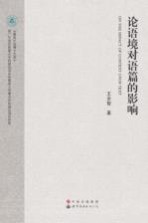

论语境对语篇的影响 英文版PDF电子书下载
- 电子书积分:9 积分如何计算积分?
- 作 者:王全智著
- 出 版 社:广州:世界图书广东出版公司
- 出版年份:2014
- ISBN:9787510069918
- 页数:198 页
Chapter 1 Introduction 1
1.1 Rationale 1
1.1.1 Motivation of this study 3
1.1.1.1 Sterility of structuralist studies of language 3
1.1.1.2 Limitations of Z.S.Harris's Discourse Analysis 8
1.1.2 Insufficiency of Halliday's exploration of context and text 11
1.1.3 Significance of this current study 12
1.2 Research Methodology 12
1.3 Collection and selection of corpora 13
1.3.1 Data collection and selection 13
l.3.2 Justification for the adoption of spoken prose as corpora 13
l.3.3 Transcription of real-life spoken data 14
1.4 Theoretical framework of this study 15
1.5 Structure of this research 16
Chapter 2 Literature Review on Context of and Text 18
2.1 Introductory remarks 18
2.2 Context 18
2.2.1 Context defined by different linguists 19
2.2.1.1 Malinowski's definition of context 19
2.2.1.2 J.R.Firth's definition of context 21
2.2.1.3 Halliday and Hasan's notion of context 22
2.2.1.4 Roman Jacobson's definition of context 23
2.2.1.5 D.Hymes's definition of context 25
2.2.1.6 Elinor Ochs's definition of context 29
2.2.1.7 CHEN Wangdao's definition of context 30
2.2.2 Cognitive context 31
2.2.2.1 Philosophers'statement of objective context and cognitive context 32
2.2.2.2 Context in cognitive linguistics 34
2.2.2.3 Problems with the theory of cognitive context 35
2.3 Text 35
2.3.1 Text,discourse,conversation 35
2.3.1.1 van Dijk's definition of text and discourse 36
2.3.1.2 Halliday and Hasan's definition of text 37
2.3.1.3 Brown and Yule's definition of discourse and text 38
2.3.1.4 Beaugrande and Dressler's definition of text 38
2.3.1.5 Coulthard's definition of discourse 40
2.3.1.6 Fowler's notion of text and discourse 40
2.4 Text and Context in this research 41
2.4.1 Text in this research 42
2.4.1.1 Informativity 42
2.4.1.2 Semantic compatibility 47
2.4.1.3 Associability 48
2.4.1.4 Cognitivity 49
2.4.1.5 Length felicity 51
2.4.2 Context in this research 53
Chapter 3 Impact of Field upon Text 55
3.1 Introductory remarks 55
3.2 Field and its components 56
3.2.1 Suzanne Eggins's description of field 57
3.2.2 Leckie-Tarry's description of field 58
3.2.2.1 Arena/activities 58
3.2.2.2 Participants 59
3.2.2.3 Semantic domain 60
3.2.3 A brief summary 61
3.3 The impact of field upon text 63
3.3.1 The impact of subject matter upon text 63
3.3.2 The impact of participants upon text 68
3.3.3 The impact of setting upon text 74
3.3.3.1 Conversation inside the classroom 75
3.3.3.2 Conversation outside the classroom 83
3.4 Summary 86
Chapter 4 Impact of Tenor upon Text 87
4.1 Introductory remarks 87
4.2 Different definitions of tenor 87
4.2.1 Gregory's definition of tenor 88
4.2.1.1 Personal tenor 88
4.2.1.2 Functional tenor 89
4.2.2 Poynton's definition of tenor 91
4.2.2.1 Power 91
4.2.2.2 Contact 92
4.2.2.3 Affective involvement 92
4.2.3 Martin's definition of tenor 93
4.2.3.1 Status 93
4.2.3.2 Contact 93
4.2.3.3 Affect 94
4.2.4 Leckie-Tarry's definition of tenor 94
4.2.4.1 Formality 94
4.2.4.2 Role 95
4.2.4.3 Focus 95
4.2.5 A brief summary 96
4.3 Impact of tenor upon text 99
4.3.1 Impact of power upon text 99
4.3.2 Impact of contact upon text 105
4.3.3 Impact of affective involvement upon text 113
4.4 Summary 116
Chapter 5 Impact of Mode upon Text 117
5.1 Introductory remarks 117
5.2 Definitions of mode 117
5.2.1 Halliday's definition of mode 117
5.2.2 Leckie-Tarry's definition of mode 118
5.2.2.1 Planning 118
5.2.2.2 Feedback 119
5.2.2.3 Contextualization 120
5.2.2.4 Medium 121
5.2.3 Martin's definition of mode 122
5.2.3.1 Spatial/interpersonal distance 122
5.2.3.2 Experiential distance 123
5.2.4 Summary of the quoted definitions 125
5.2.5 The definition of mode to be taken in this research 126
5.3 Impact of mode upon text 126
5.3.1 Differences between spoken mode and written mode 126
5.3.1.1 Referential choices between spoken mode and written mode 131
5.3.1.2 Nominalization:a typical feature of written mode 132
5.3.2 Written-to-be-spoken mode and its actualization 137
5.3.3 Internet relay chat and face-to-face conversation 142
5.3.3.1 Sequential organization in QS-CMC:The misinterpretation of adjacency 144
5.3.3.2 Phantom responsiveness and phantom adjacency pairs 145
5.3.3.3 Turn-taking in QS-CMC:The problem of virtual simultaneity 149
5.3.3.4 The misinterpretation of silence 152
5.3.3.5 Miscommunication in QS-CMC 153
5.4 Summary 155
Chapter 6 Interaction between Contextual Factors and Its Impact upon Text 156
6.1 Introductory remarks 156
6.2 Contextual factors revisited 157
6.3 Impact of field upon mode 159
6.4 Impact of mode upon tenor 163
6.5 Impact of tenor upon field 169
6.6 Impact of tenor on mode 170
6.7 Impact of field upon tenor 176
6.8 Summary 178
Chapter 7 Conclusion 179
7.1 Conclusions 179
7.2 Contributions of the current research 179
7.3 Insufficiencies of the current research 180
7.4 Suggestions for future research 182
7.5 Pedagogical implications of this research 183
References 186
- 《卓有成效的管理者 中英文双语版》(美)彼得·德鲁克许是祥译;那国毅审校 2019
- 《影响葡萄和葡萄酒中酚类特征的因素分析》朱磊 2019
- 《环境影响评价公众参与理论与实践研究》樊春燕主编 2019
- 《AutoCAD 2018自学视频教程 标准版 中文版》CAD/CAM/CAE技术联盟 2019
- 《跟孩子一起看图学英文》张紫颖著 2019
- 《人性的优点 全球具有影响力的励志畅销书》王平,范厚莉编著 2018
- 《AutoCAD机械设计实例精解 2019中文版》北京兆迪科技有限公司编著 2019
- 《大气氮沉降及其对生态系统的影响》方琨,王道波 2019
- 《复分析 英文版》(中国)李娜,马立新 2019
- 《工作-家庭支持氛围影响机制的实证研究》刘崇瑞 2019
- 《中国的新型正义体系》黄宗智著 2019
- 《水工程法规 第2版》张智著 2018
- 《高效棉纺精梳关键技术》任家智著 2017
- 《汉语成语接龙词典》刘克智著 2013
- 《城市体育公共服务运行机制研究》周曰智著 2017
- 《告别的时代》老智著 2018
- 《朝华童文馆 小故事大道理 6-10岁 领诵版》弘智著 2017
- 《朝华童文馆 王子故事书 6-10岁 领诵版》弘智著 2017
- 《朝华童文馆 中外名人故事 6-10岁 领诵版》弘智著 2017
- 《朝华童文馆 益智故事 6-10岁 领诵版》弘智著 2017
- 《TED说话的力量 世界优秀演讲者的口才秘诀》(坦桑)阿卡什·P.卡里亚著 2019
- 《小手画出大世界 恐龙世界》登亚编绘 2008
- 《近代世界史文献丛编 19》王强主编 2017
- 《课堂上听不到的历史传奇 世界政治军事名人 初中版》顾跃忠等编著 2015
- 《365奇趣英语乐园 世界民间故事》爱思得图书国际企业 2018
- 《近代世界史文献丛编 36》王强主编 2017
- 《近代世界史文献丛编 11》王强主编 2017
- 《近代世界史文献丛编 18》王强主编 2017
- 《乐队伴奏长笛世界名曲集 4》芭芭拉·哈斯勒-哈瑟 2017
- 《世界名著阅读经典 欧也妮·葛朗台 高老头 全译本 12-16岁》(法)巴尔扎克著 2017
